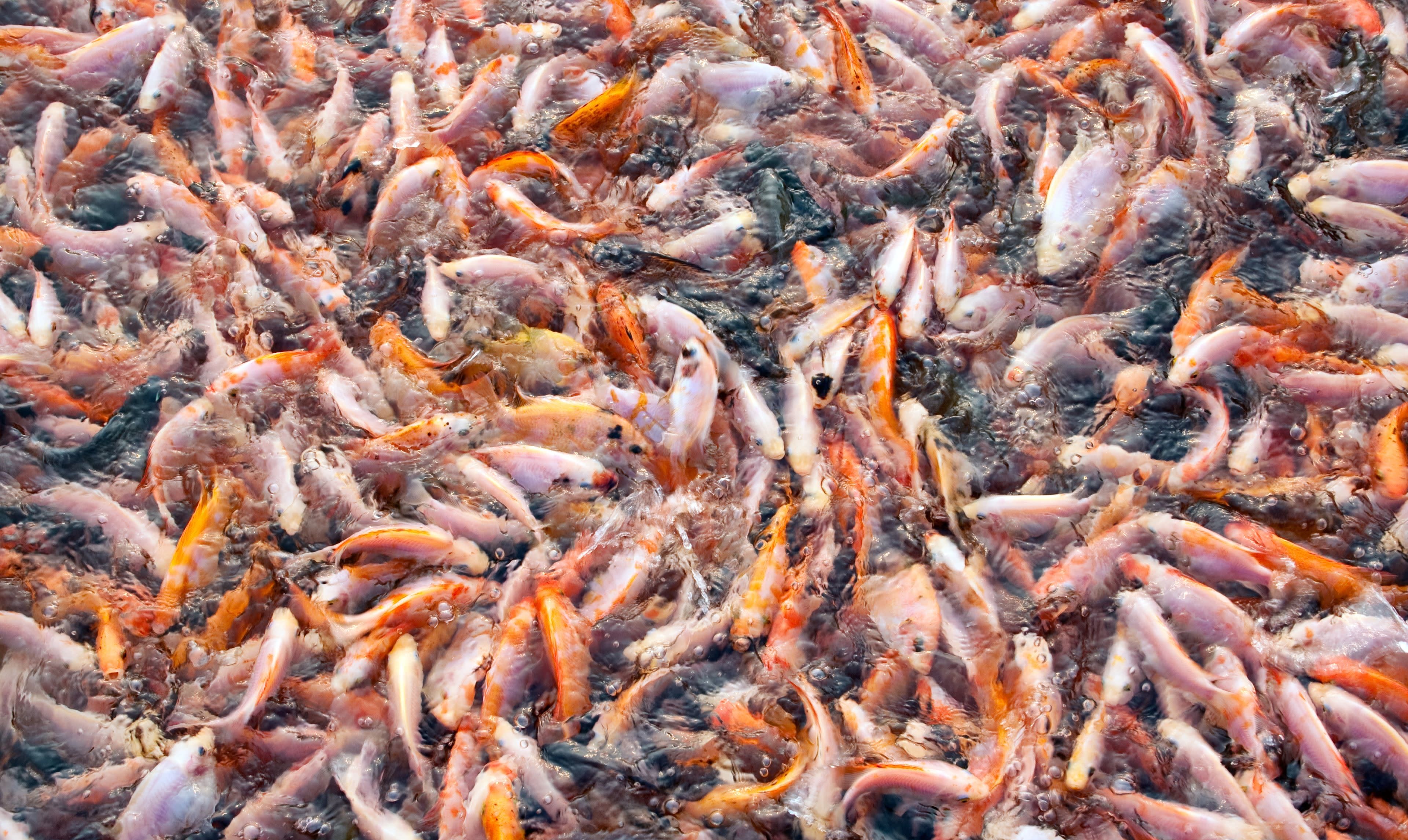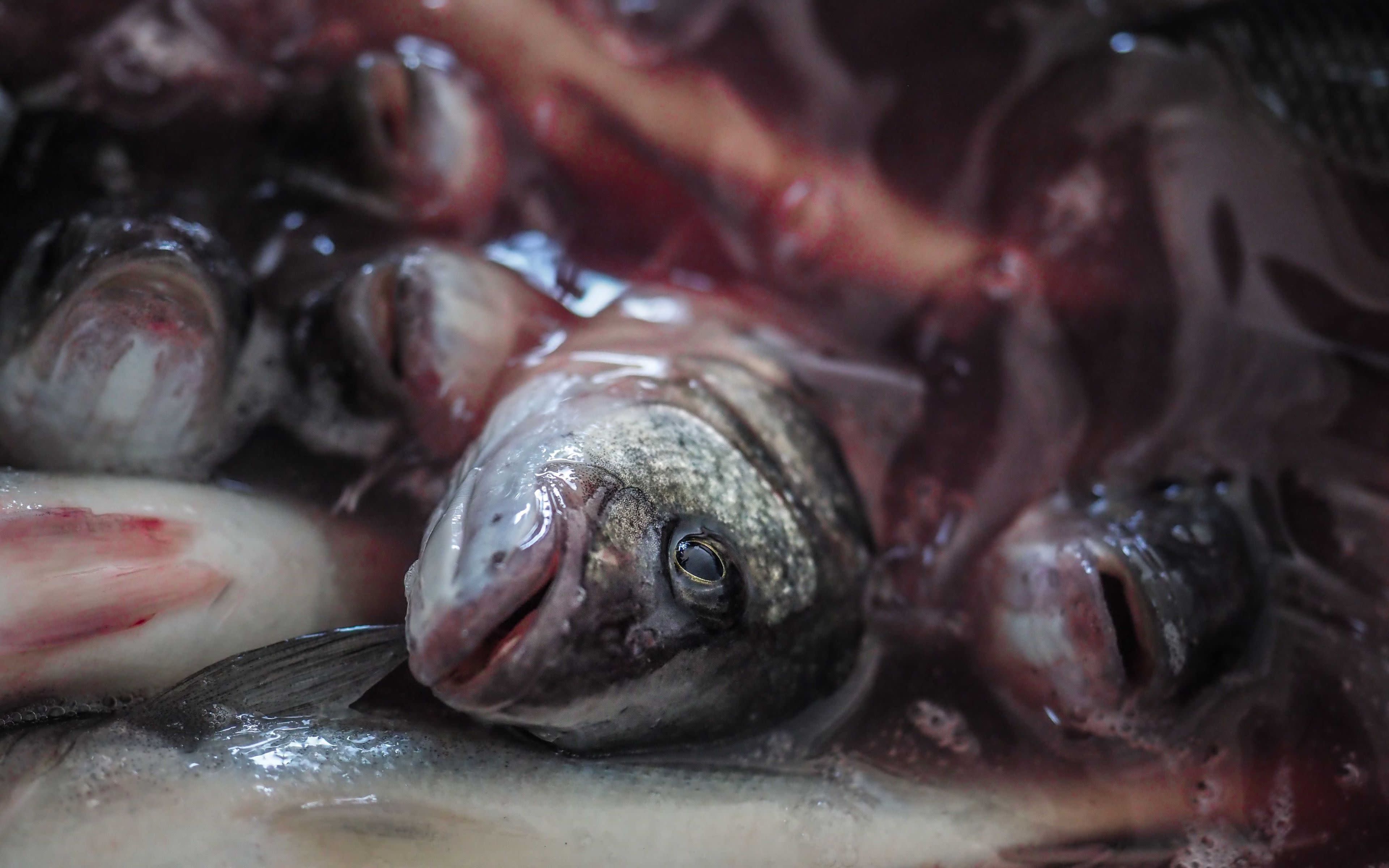




Factory fish farms confine high densities of fish within small containers or nets for their entire lives—something that's particularly unnatural for species like salmon, which would otherwise migrate thousands of miles.

Fish have long been misunderstood. These aquatic animals are sometimes thought to be closer to plants, existing merely as streams of protein mindlessly swimming through the water. Goldfish are assumed to have no memory since they swim endlessly back and forth within the tiny confines of their bowls. But the truth of these beliefs is far more complex. Many people, for example, don't consider that the goldfish has nowhere else to go, and could be pacing as a result of chronic boredom, stress, or both.
The misconceptions around who fish are have helped facilitate their exploitation on fish factory farms, where there is no regard for their welfare.
WHAT IS FISH FARMING?
Imagine a swimming pool filled to the brim with fish, the water muddied with fish excrement. Now imagine ten of these in an indoor shed, or in the ocean, with nets for boundaries instead of solid walls. This is what factory fish farming looks like, where fish are held captive for their whole lives, manipulated from birth to death, all so that people can make a profit and satisfy the intense consumer demand for fish flesh.
Schools of fish would never be so densely packed in the wild.
Fish farming is practiced in many countries around the world and can take different forms. Farms can be immersed within bodies of water, including lakes, ponds, or in the ocean. They can also be based on land, where fish are kept in tanks. These facilities can vary significantly in size. Some fish farms can be extensive, meaning that they keep fish in relatively natural conditions without adding a host of antibiotics and other artificial chemicals to the water or to the fish. These farms rely instead upon the natural environment to provide the conditions in which the fish can live.
This is a stark contrast to intensive fish farming, which activists also refer to as as fish factory farming. These facilities are characterized by holding extremely high densities of fish within small containers or nets for their entire lives—something that's particularly unnatural for species like salmon, which undertake migrations of thousands of miles, or else are constantly on the move over large areas.
WHAT IS THE MOST FARMED FISH?
A wide array of fish species are farmed in countries around the world. The most popular is the grass carp, a large freshwater fish raised for food in China. Other popular species include tilapia and salmon.
But regardless of the species, no fish deserves to be subjected to the harsh realities of factory fish farming.
WHAT'S THE DIFFERENCE BETWEEN FACTORY FISH FARMING AND AQUACULTURE?
Aquaculture refers broadly to all types of water-based agriculture that target aquatic plants and animals. Seaweed and algae cultivation are among the least harmful forms of aquaculture when it comes to welfare. Mollusks, or shellfish, are also common targets for aquaculture, including species like oysters, mussels, and clams, as are crustaceans such as shrimp.
No matter the species, industrial aquaculture carries various environmental risks—and the bigger the operation, the greater the hazards.
WHY IS FISH FARMING BAD?
Farming, especially on an industrial scale, is synonymous with human domination. Fish farming is no different. Fish are summoned into life for one single purpose: as food for human beings. Between being born and their often painful deaths, fish on farms are often prevented from living in their natural habitats, as their freedom to choose the direction of their own lives is forever denied.
Below are some of the most troubling impacts of factory fish farming.
Crowded ponds and cages
Factory farms are also known as concentrated animal feeding operations—“concentrated” being the key word. To maximize profits, fish farms cram as many individual fish into the smallest spaces possible, whether that's inside artificial tanks or suspended in nets within the ocean. Thousands of fish can be stuffed into these tiny spaces, forced to live in schools that would never be so dense in the wild. These confines prevent fish from freely moving and exploring their natural habitat.
Use of antibiotics
The highly crowded and unnatural conditions on fish factory farms mean that fish can become chronically stressed, which in turn can suppress their immune systems. The pollution generated by enclosing so many animals in small spaces can also give rise to the spread of diseases, thanks to the rapid build-up of excrement. This is where antibiotics come in—an overused tool in the cruel arsenal of factory farming. These drugs are often applied liberally throughout the fish’s lives to stave off the disease that would otherwise kill most, if not all, factory-farmed fish. Antibiotics are also used to promote the faster growth of fish so that they reach marketable size more quickly, thereby maximizing profits for farm owners.
Antibiotic use on fish farms is a major cause of antibiotic resistance, whereby these drugs become ineffective even in human beings, who are unintentionally exposed through consuming fish meat or coming into contact with contaminated water. Antibiotic resistance is considered one of the biggest threats to human health that the world currently faces.
Bad for communities
Coastal communities are especially vulnerable to water-based fish factory farms thanks to the environmental devastation they cause. Sullying the waters and killing off local fish populations can be bad for tourism, as well as subsistence or small-scale fisheries, disrupting the food cultures of communities who have relied upon their fisheries for hundreds or even thousands of years.
The wild salmon population has dwindled to dangerously low levels.
One example of the damage large fish farms can cause comes from the west coast of Canada, where Indigenous tribes have been fighting commercial fish farms for many years. On their annual migrations, wild salmon pass through waters that are now heavily contaminated by fish farms, where they get exposed to a host of antibiotics, chemicals, and diseases that can lead to sickness and death. The wild salmon population has been dwindling to dangerously low levels, leading many to sound the alarm that there may one day be none left in the area.
The impacts of this shift would be devastating not only for the fish themselves but for the Indigenous communities who rely upon them for food and cultural purposes. Indigenous communities respect these fish in ways that commercial operations do not, and they can act as effective stewards of the population, rather than exploit them for monetary gain.
Spreading diseases to wild fish
When fish farms are immersed into natural bodies of water, wild fish populations are free to approach these facilities, and many do, especially when farms are situated in ecologically diverse areas. Wild fish living adjacent to these farms, or even just those passing through, become susceptible to diseases or parasitic infections that may be lingering within the farmed population. One of the most prevalent exchanges occurs within wild salmon populations in the form of sea lice, a parasite that latches onto salmons’ bodies and feeds on their flesh and blood, causing painful lesions and sometimes mass death. Other infections include whirling disease, which infects rainbow trout populations, and crayfish plague, a mold that infects and kills crayfish within weeks.
Health risks for consumers
Farmed fish are exposed to various drugs and chemicals throughout their lives, some of which can remain in their bodies as people consume them. Chemicals of concern include dyes, used to make the flesh of salmon appear pinker and more appealing; fungicides, which inhibit the growth of fungus on fish eggs; and persistent organic pollutants, including dioxins and PCBs that are thought to increase risks of cancer and interrupt the endocrine system.
Behavioral issues
Fish farms can cause behavioral issues that are not unlike human behavioral issues. Imagine being cooped up in one room for your whole life, surrounded by other people from whom you can’t escape, without any opportunity for privacy or to exercise your free will. This would undoubtedly take a serious toll on even the strongest person. It should not be all that surprising, then, that fish behave differently on fish farms than they do in the wild.
One study found that up to a quarter of fish on fish farms float listlessly at the surface of the water of their enclosures. These fish were found to have elevated levels of cortisol, the hormone related to stress, and their brain chemistry was very similar to that of a human suffering from depression.
Considering the conditions that farmed fish are forced to endure, their depression seems only natural—and something they did nothing to deserve.
IS FISH FARMING CRUEL?
The belief that fish cannot feel any pain continues to be stubbornly persistent and is part of the reason why people find it acceptable to keep fish in such terrible conditions. But the science demonstrates that not only are fish able to experience physical pain, they experience psychological pain as well. Given what is now known about the cognitive and emotional abilities of fish, the conditions on fish farms should unanimously be considered cruel, especially since fish welfare has long been insufficient when it comes to industrial fish farming.
HOW YOU CAN HELP
If you live in a place where abundant plant-based proteins are available and accessible, eliminating fish from your diet is a great way to reduce the suffering these animals experience on farms. And sharing this article with friends and family will help dispel some of the harmful myths about who fish are and what they endure on factory farms: facilities that are so often hidden from public view, as are their many health impacts.
Dietary changes and increased awareness may one day lead to a future where fish no longer suffer on factory farms.





